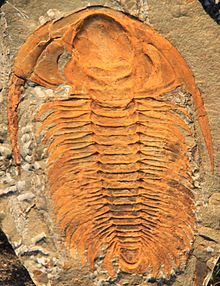At https://phys.org/news/2019-06-king-fossils-kangaroo-island.html … fossils of a long extinct group of sea creatures known as the trilobites have been found on Kangaroo Island which lies off the coast of South Australia. Presumably this is part of the Australian continental shelf system and formerly land that has been flooded post Pleistocene. In any event it is remarkable that marine fossils are found on what is still land – albeit an island. Not only that but the trilobites are described as having been smashed or crushed. It is speculated that an unknown predator did this – but was it all part of the demise of these incredible animals, vague relatives of modern crustaceans such as crabs. Mind you, in evoltuionay terminology the trilobites had developed a form of armour against predators – possibly another sea creature (giant shrimps have been suggested for example but anything is possible, even a shell eating fish like entity of some kind). Trilobites had hard, calcified, armour like skeletons (somewhat akin to a giant woodlice in shape and armour).
 … They are one of the most common fossils in the Cambrian rocks (and part of the so called Cambrian Explosion of life forms). In other words, they are one of the most common fossils that appear in the Cambrian catastrophe (without prejudging the nature of that catastrophe, only that it involved a lot of marine life). The trilobites of Kangaroo Island were bigger than any trilobites that have yet turned up in rocks. They grew up to 30cm in length but exhibit injuries that seem to be caused by shell crushing predators. There are also copralites (fossil dung) that contain trilobite fragments which leads to the assumption they had been eaten. Or does it? Copralites of the Cambrian are usually small – even described as microscopic. However, for further reading go to https://en.wikipedia.org/wiki/Copralite … which gives a good view of what they are and www.nationalgeographic.com/science/prehistoric-world/cambrian/ .. which has an image of a shrimpl like sea monster that is suggested as being responsible for preying on trilobites. See also the excellent post at https://en.wikipedia.org/wiki/Cambrian_explosion … which describes the difficulties that Darwin had as the Cambrian Explosion (a marker of the end of that period) shows the seas were teeming with life yet there are no fossils to show their evolution earlier in the Cambrian. Presumably if one sees the Explosion as a catastrophic event bringing the Cambrian to an end there would be no need to expect earlier fossils if no catastrophe had occurred to preserve them. It is also quite obvious that a lot of animals evolved prior to the Exlosion (or extinction event). How much earlier is the big question.
… They are one of the most common fossils in the Cambrian rocks (and part of the so called Cambrian Explosion of life forms). In other words, they are one of the most common fossils that appear in the Cambrian catastrophe (without prejudging the nature of that catastrophe, only that it involved a lot of marine life). The trilobites of Kangaroo Island were bigger than any trilobites that have yet turned up in rocks. They grew up to 30cm in length but exhibit injuries that seem to be caused by shell crushing predators. There are also copralites (fossil dung) that contain trilobite fragments which leads to the assumption they had been eaten. Or does it? Copralites of the Cambrian are usually small – even described as microscopic. However, for further reading go to https://en.wikipedia.org/wiki/Copralite … which gives a good view of what they are and www.nationalgeographic.com/science/prehistoric-world/cambrian/ .. which has an image of a shrimpl like sea monster that is suggested as being responsible for preying on trilobites. See also the excellent post at https://en.wikipedia.org/wiki/Cambrian_explosion … which describes the difficulties that Darwin had as the Cambrian Explosion (a marker of the end of that period) shows the seas were teeming with life yet there are no fossils to show their evolution earlier in the Cambrian. Presumably if one sees the Explosion as a catastrophic event bringing the Cambrian to an end there would be no need to expect earlier fossils if no catastrophe had occurred to preserve them. It is also quite obvious that a lot of animals evolved prior to the Exlosion (or extinction event). How much earlier is the big question.
